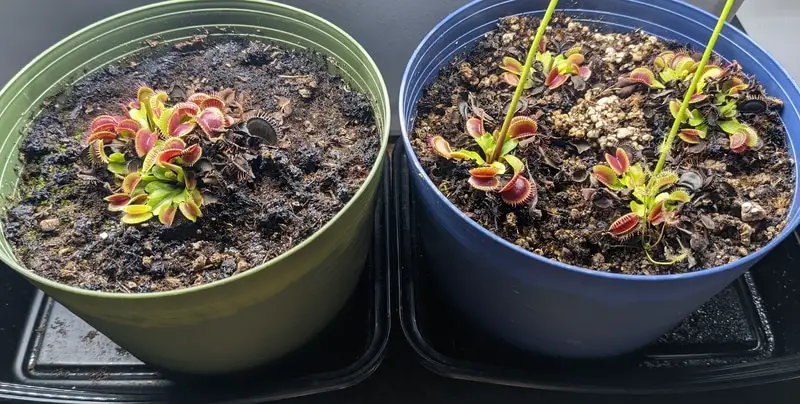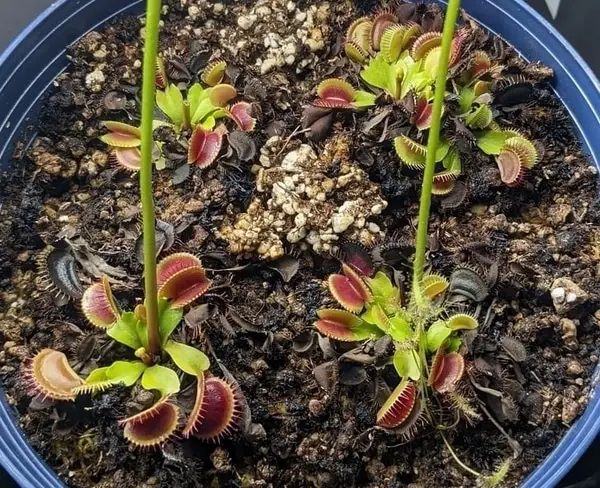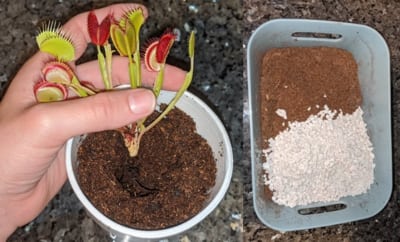
Selecting the wrong pot or growing container for your Venus flytrap can harm or even kill it. In this article, I will share a guide for selecting the best pots for your Venus flytrap.
As a general rule, plastic, styrofoam, or glazed ceramic pots are suitable for Venus flytraps, while terra cotta, concrete, or unglazed ceramic pots should be avoided. Venus flytraps prefer tall pots 4-6 inches in diameter and at least 4 inches in depth.
The size, color, and material of the pot can affect your plant’s health. I experimented with several types of pots over the years and have followed many different pieces of advice. This article will share a guide to picking the best containers for your Venus flytrap.
When selecting a pot for your Venus flytrap, make sure to follow these considerations:
| Suitable materials | Glazed ceramic, plastic, resin, styrofoam |
| Unsuitable materials | Concrete, unglazed ceramic, clay, terra cotta, metal |
| Diameter | 3-6 inches for single plants, 6+ inches for multiple |
| Depth | 4 inches is the minimum recommended depth |
| Drainage | Must contain drainage holes |
| Color | Avoid black pots in extremely hot locations |
| Airflow | Avoid closed containers, such as terrariums and domes, at all costs |
The Best Containers and Pots for Venus Flytraps
I have tried several pots over the years and found some that work great for Venus flytraps and other carnivorous plants.
These pots are great for Venus flytraps: https://amzn.to/3IYVGKU .
.
The link will take you to Amazon.com, where you can check the price and choose a color. They are affordable (usually less than 20 dollars), have proper drainage, are tall enough to promote growth, and the plastic is safe for your plants. For the size, I recommend the 5.5 or 6.5-inch pots for a single plant and the 7.5-inch pot for multiple plants. Also, choose the white pots for hot outdoor locations for better insulation.
The product links I provide are for reference, as many other pots can fulfill the requirements of Venus flytraps 😉
In the upcoming sections, I will explain the importance of selecting the appropriate material, size, color, and drainage for your pot, including some tips from a fellow carnivorous plant hobbyist. The information will help you select the best pot for your plant! 🙂

You can repurpose containers and use them as plant pots or buy some in gardening shops. I grow several different carnivorous plants and like to keep the pots uniform.
Container Material
Venus flytraps are very picky in which soil, water, and pot they require. They are intolerant to minerals and nutrients, making finding a suitable growing container difficult.
The best pot materials for Venus flytraps are plastic, styrofoam, or glazed ceramic pots. These materials provide insulation from extreme temperatures and are harmless to your plants. They do not leak any minerals into the soil. It is not common to find styrofoam plant pots, but some people repurpose styrofoam cups as pots for small plants. They are an inexpensive option, and they provide the best insulation (remember to add drainage holes).
Over time terracotta, unglazed ceramic, concrete, or metal containers leach harmful minerals into the soil. Those added minerals build up in the ground and can eventually start killing your Venus flytrap. An increase in black leaves or the appearance of yellow leaves is sometimes a sign of mineral burns caused by using the incorrect pot material, soil, water, or a combination of several.
Glass pots are acceptable containers. They do not leak any type of element into the soil, but insulation can be a challenge. Make sure to avoid extreme temperatures if using metal or glass pots.

Pot Size
Choose a pot that matches the size of the Venus flytrap, but opt for larger pots rather than small ones. Small pots can restrict your plant’s growth. An adult Venus flytrap grows best in the following dimensions:
- Pot diameter: 4 to 6 inches (10.5cm – 15.2 cm)
- Pot depth: Over 4 inches (10.2 cm)
Young Venus flytraps that are only 1 to 2 years old can grow in 2 to 3 inches in diameter pots.
If you wish to grow multiple Venus flytraps in the same pot, choose large pots of at least 6 inches in diameter. Currently, I have 4 Venus flytraps growing in an 8-inch pot. They are comfortable in the space, and they make the pot look full and interesting.
Drainage
Venus flytraps require a very moist environment to stay healthy; however, they can be prone to root rot when drainage is not optimal.
Always employ a pot with drainage holes to grow Venus flytraps. The drainage holes will allow you to water your plant from the bottom and prevent rotting, molding (this is how you can get rid mold) , and algae.
It is possible to grow a Venus flytrap in a container without drainage, like a terrarium, for example, but it is challenging. As a beginner carnivorous plant grower, I wouldn’t suggest experimenting with terrariums just yet.
Color
The color you choose for your pot is not as critical as all other factors. However, you should consider the weather in your area.
Choosing a light color pot can help with insulation in an extremely sunny location. I live in Arizona and try to use white pots for all my outdoor plants.
Airflow
Closed containers, such as domes or terrariums, can be very harmful to Venus flytraps. These plants appreciate the extra humidity, but they are prone to rotting in soggy environments. Without the appropriate drainage and airflow, Venus terrariums often kill the plant or cause mold or algae issues.
Additional Considerations
Water Trays
To water Venus flytraps appropriately, you will most likely need water a tray. Most pots come with their own trays, but if needed, you can use any container as a tray. I use these large plastic trays to hold multiple of my plants.
to hold multiple of my plants.
Overall, you want to avoid materials such as terracotta, clay, unglazed ceramic, and metal for your water tray.
Soil
Now, let’s select an appropriate potting medium. Venus flytraps can’t grow in standard compost or potting soil due to the richness in nutrients. Instead, you must employ a mixture of these nutritionless elements:
- Long fibered sphagnum moss
- Peat moss
- Silica sand
- Perlite
To make Venus flytrap soil combines one type of moss with a draining agent (sand or perlite). For example, you can employ a 2:1 ratio of peat moss and perlite. Or a 2:1 ratio of long-fibered sphagnum moss with sand. The ratio depends on personal preference, but a 2:1 or 4:1 ratio are common choices.
When selecting the soil, make you find the correct type. Here is a guide that lists the best soil options .
.
It is acceptable to employ pure peat or sphagnum moss as the ground for Venus flytrap. However, it is encourage to add sand or perlite to provide better drainage and aeration.
You can buy the ingredients listed above and make your own Venus flytrap soil or buy it online. If you would like to make it yourself, this article has complete instructions.
has complete instructions.
Here is the amazon link of the carnivorous plant soil I use for my carnivorous plants. It is affordable and very effective in keeping your plants healthy: https://amzn.to/3Nhy4qM
Venus Flytrap Care 101
Growing a Venus flytrap in the right setup ensures your plant will stay healthy and thrive. This list contains the most critical considerations when growing Venus flytraps. Read my complete care guide here.
here.
| Light | Provide over 6 hours of sunlight or artificial lighting |
| Soil | Employ carnivorous plant soil |
| Pot | Use plastic or glazed ceramic pots with drainage |
| Water | Water frequently to keep the soil humid at all times with distilled or rainwater. |
| Temperature | Avoid temperatures below 20F and above 100F |
| Location | For best results, grow Venus flytraps outdoors |
The Best Containers for Carnivorous Plants
If you have other carnivorous plants make sure to check my guides on pots and growing containers for Sundews and Pitcher plants:
The Best Pots for Sundews Plus Potting Guide
The Best Pots for Pitcher Plants Plus Potting Guide
Recommended Products for Growing Carnivorous Plants
Finding the best pots, lights, and soil for carnivorous plants is difficult. I have grown carnivorous plants for over 5 years, and these are the products I use. The links will take you to Amazon to view the prices and full specs:
- Carnivorous Plant Soil
- Carnivorous plant soil: https://amzn.to/422yLZa

- Carnivorous plant soil: https://amzn.to/422yLZa
- Artificial Lighting
- Small plant light for 1-2 plants: https://amzn.to/3oQsmSj

- T8 LED light fixture for multiple plants (6500k Cool White): https://amzn.to/3uWoeh2

- Small plant light for 1-2 plants: https://amzn.to/3oQsmSj
- Pots and Miscellaneus
- Nursery pots for single plants: https://amzn.to/3oL8YGq

- Nursery pots for single plants: https://amzn.to/3oL8YGq
- TDS meter to measure water quality: https://amzn.to/3g8VKLI

- Dried crickets to feed carnivorous plants: https://amzn.to/34QEnKv

